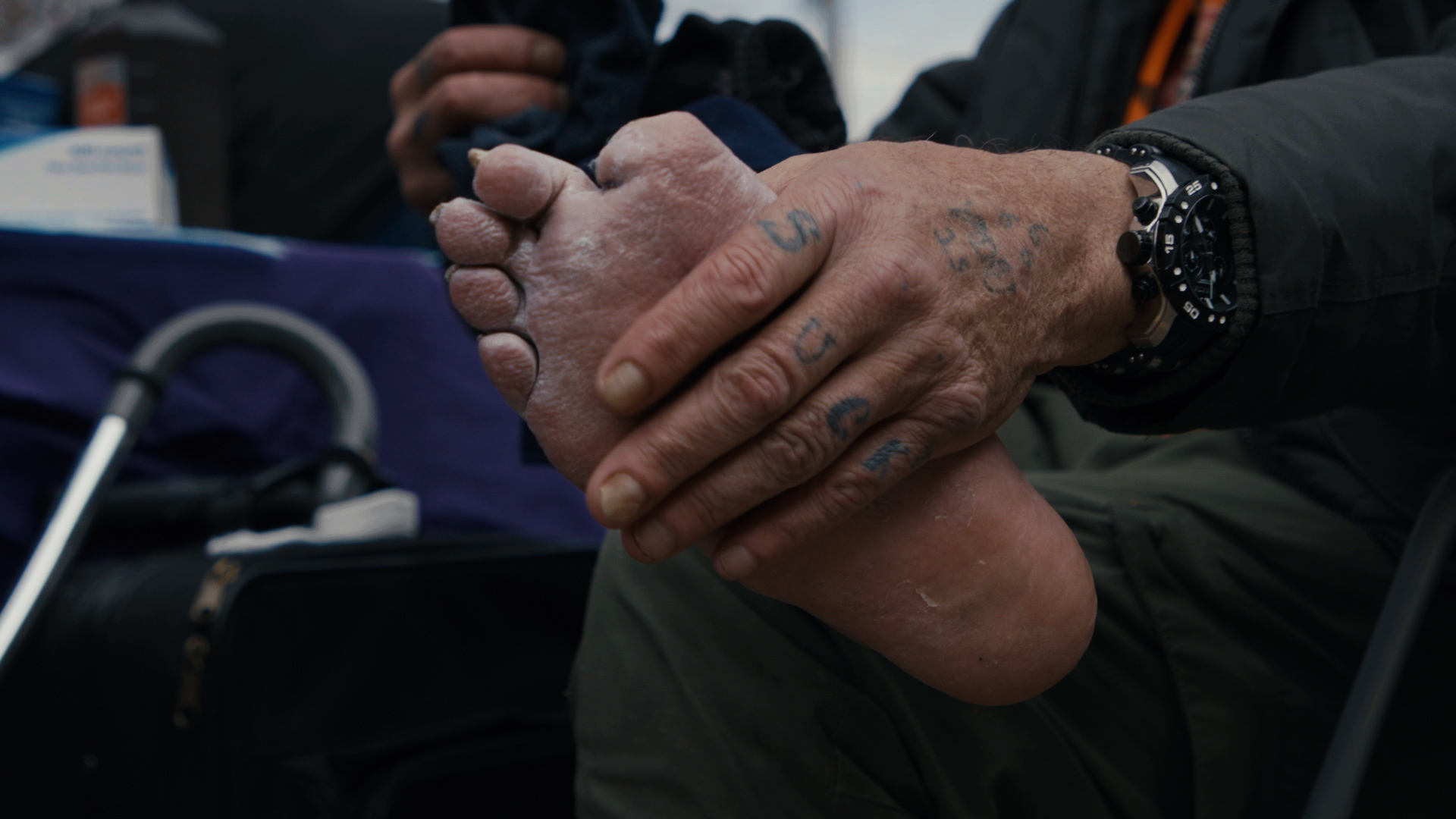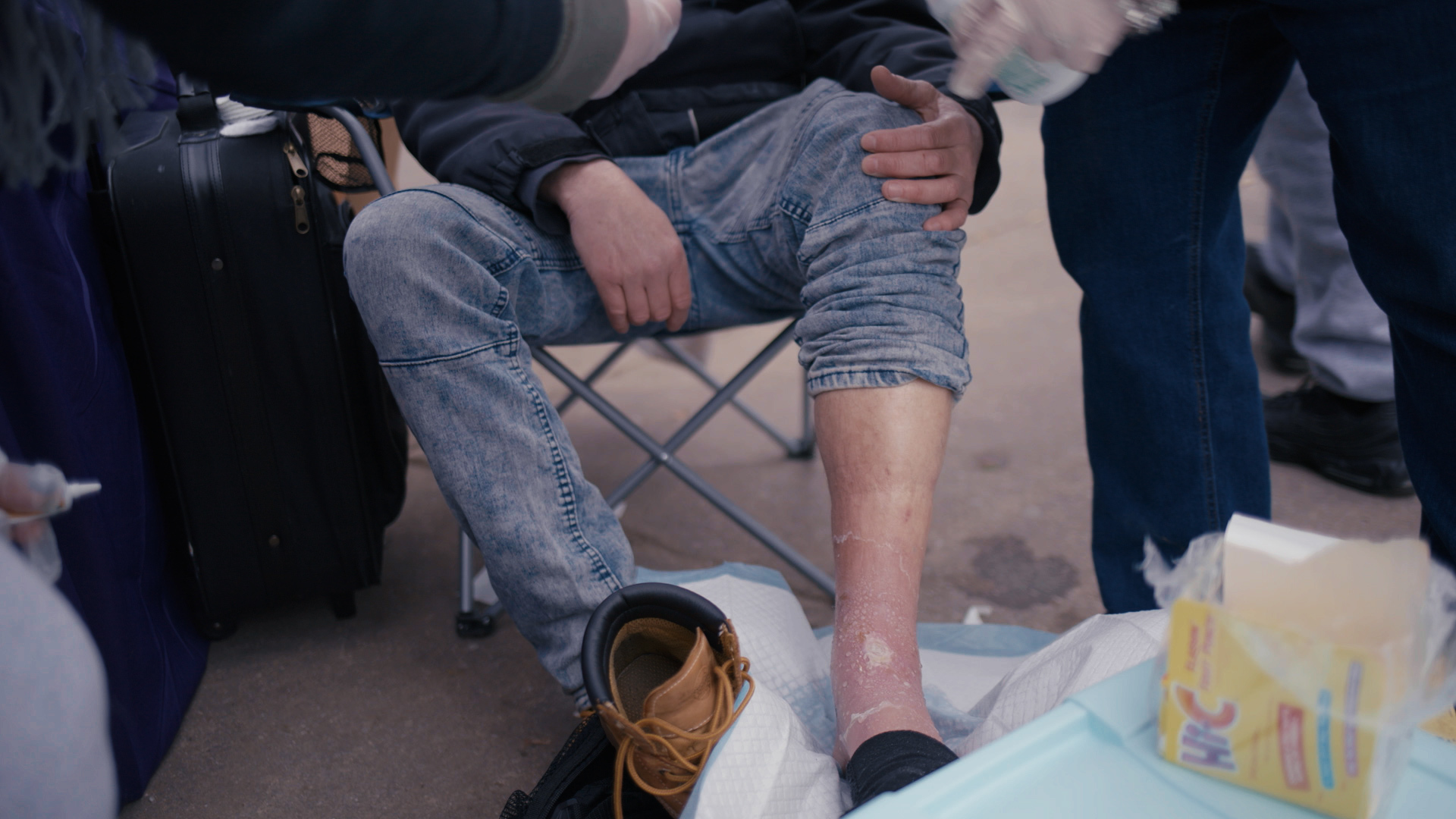Warning: This story contains graphic content about injection drug use that might disturb some readers.
PHILADELPHIA — Bill’s hands are so disfigured that he can no longer fit gloves over them.
Videos by VICE
About two months ago, his right ring finger was amputated. In a matter of weeks, he could lose the middle finger on his left hand, which was swollen with a large, maroon-colored sore covering the knuckle when VICE News met him on a recent morning in Philadelphia’s Kensington neighborhood.
The lesions are markers of a drug Bill said he never intended to consume. Xylazine, an animal tranquilizer known on the street as “tranq” or “tranq dope,” has infiltrated Philly’s illicit opioid supply. The 59-year-old, who did not share his last name with VICE News, shivered as he hunted for mittens at an outreach event for drug users in Kensington.
“Boy, this is angry,” said a nurse who volunteers with the harm reduction group Savage Sisters, while examining a wound on one of Bill’s fingers at a pop-up wound care clinic at Kensington’s McPherson Park, known locally as Needle Park because of its open-air drug use.

Bill said he hates the sedative effect of xylazine—which is most commonly mixed with fentanyl—because it knocks him out for hours at a time; he also believes it’s causing sores to break out all over his body.
“I never shoot up in my hands, but I get abscesses in my knuckles, in the tops of my fingers,” Bill said. “[They’re] caused by whatever they’re putting in the drugs.”
VICE News spent a week in Philadelphia, where the drug was detected in less than 2 percent of fatal opioid overdoses between 2010 and 2015—but jumped up to 31 percent in 2019.
Repeated tranq use is believed to be causing wounds on users’ bodies, and like Bill’s, they’re not limited to injection sites but are showing on people’s hands and legs, in some cases resulting in amputations. The problem is so bad that Philadelphia, ground zero for tranq in the U.S., is looking to hire a wound care specialist and a field nurse to deal specifically with tranq-related lesions. Drug users and harm reduction advocates said tranq is also creating a whole new kind of physical dependence—with people passing out for hours at a time and waking up craving more.
“Philly’s going under from tranq.”
While there are some strides being made to help people within the city, the issue has largely flown under the radar, even as tranq spreads to other parts of the U.S., including Maryland, Connecticut, Massachusetts, and North Carolina.
“It’s killing us,” said Sam Brennan, 28, a tranq user who is living in a shelter in Kensington. She said conditions in the neighborhood, where residents contend with extreme poverty and drugs are sold openly (samples are sometimes given out for free), have deteriorated with the proliferation of tranq.
“It’s something I’ve never seen before anywhere else. People all over the place, sticking needles anywhere they possibly can, passed out. Philly’s going under from tranq.”
Tranq first showed up in medical examiners’ reports in Philadelphia in 2006, according to Jen Shinefeld, a field epidemiologist with the city who focuses on substance use. But in the past two years, its reach has exploded. Of the 200 samples of dope (primarily fentanyl) the city has tested since September 2020, all of them have come back with tranq in them, Shinefeld said. A study published recently in Drug and Alcohol Dependence found that in 10 jurisdictions, xylazine’s prevalence skyrocketed from 0.36 percent of overdose deaths in 2015 to 6.7 percent in 2020.
The dosing in the street supply varies wildly, Shinefeld said, with some batches containing barely any opioids and heavily skewed toward tranq.
Sitting on the stoop of a church at dusk, Brennan explained that she started using heroin, or “brown dope,” when she was 12, about 16 years ago. Then three or four years ago, she remembers looking for a batch (known locally as a “stamp”) of “the best dope” in town. At first, she and her girlfriend didn’t realize what they were getting wasn’t just fentanyl or heroin but an animal sedative.


“Every other stamp started getting tranq in it. We finally figured out… They were cutting the fentanyl with the tranq to make it stronger.”
She said tranq is more potent than heroin or fentanyl—and that she passes out much faster. Like opioids, tranq can cause respiratory depression, increasing the risk of overdose. But because it’s is not an opioid, its effects can’t be reversed with naloxone.
“It’s like a three-hour process—you’re going out and you’re waking up and you’re sick. And it’s a way more intense sickness than fentanyl. Brown dope was like, you’re hardly getting sick from that; that was nothing. Fentanyl was a little bit worse. But this tranq is intense. You feel like you’re literally going to die.”
“It’s eating away at my skin.”
Brennan, whose blue puffer jacket and grey sweats hung loosely off her small frame, said she’s lost at least 40 pounds since she started using tranq—she now weighs around 120 pounds. When she first started, she injected it into her veins. Pulling down her sweater, she revealed a dark sore on her neck that appeared a couple weeks after she started shooting up there. Now she shoots it straight into her muscles, explaining that the drug is so strong she doesn’t even need to find a vein.
Last Christmas, she went home to see her family for the first time in four years. She was limping because of the lesions on her leg, so she couldn’t play basketball with her nephew.
“It’s eating away at my skin,” she said.
According to a report published in Injury Prevention last year, information is limited on the effects of chronic xylazine use in the U.S. But in Puerto Rico, where it’s been consumed by drug users since at least the early 2000s, it’s been associated with skin ulcers, abscesses, and lesions.
“As skin ulcers are painful, people may continually inject at the site of the ulcer to alleviate the pain as xylazine is a potent α2-adrenergic agonist that… decreases perception of painful stimuli,” the report said. “People may self-treat the wound by draining or lancing it, which can exacerbate negative outcomes.”
Since tranq became the primary contaminant in Philadelphia’s opioid supply, soft-tissue infections have risen by 5 percent and bone disease by 20 percent, according to the city’s health department. Amputations are also on the rise, Shinefeld said. The wounds are appearing even in people who snort and smoke tranq.

Xylazine slows down blood flow, Shinefeld explained, which increases the time it takes wounds to heal and can lead to other medical complications, such as sepsis (an extreme response to infection) and endocarditis (inflammation of the heart’s inner lining).
Shinefeld said a combination of stigma tied to the sores and a lack of expertise in advanced wound care relating to tranq is stopping people from getting treated.
“We’ve done a disservice to the greater drug-using community by not doing enough education around it—to let people know that this is what it is, this is what it does,” she said.
Savage Sisters started offering guerrilla wound care at McPherson Park last year as a result of the increase in infections, according to founder Sarah Laurel, a former heroin user. One Saturday earlier this month, volunteer nurses patched people up with antibacterial bandages, antibiotic ointment, burn gel, alcohol swabs, wraps, and gauze, in a crowded and chaotic scene.
“It’s really just urgent, on the street, what we can do for them,” Laurel said.
One man sat down in a folding chair to have his left ankle looked at; his skin was red and blistering badly. He said the last time he was in hospital, he left early because he wasn’t feeling better.
“It was the worst pain I’ve ever been in in my life,” he said.

The nurse helping Bill encouraged him to go to an emergency room for intravenous antibiotics as she patched him up with a numbing ointment and bandages.
But he said hospital staff aren’t prepared to deal with people who go into tranq withdrawal while getting treated. He put off going to the hospital when his now-amputated finger was infected.
“They treat us like animals.”
Several drug users and experts said that because xylazine is a sedative, it can make fentanyl’s effects last longer, which could help explain why it’s being cut into the drug supply. Though it is not FDA-approved for human consumption, it’s not a federally scheduled drug—meaning it’s technically legal—and can be purchased easily online.
Since China, under pressure from President Donald Trump, banned fentanyl and its analogs in 2019, the usual fentanyl supply chain has been disrupted.
“When fentanyl is not available, the cuts get heavy with xylazine,” Shinefeld said. “We’ll have someone that’ll do a bag that’s 23 parts xylazine to one part fentanyl, and we’ll have 15 people (overdose) on one corner.”
Fernando Montero Castrillo, a postdoctoral fellow at Columbia University who spent years researching the drug scene in Kensington, told VICE News street dealers have very little control over what’s in the drugs they sell. But while tranq started out being laced into heroin and fentanyl, it now has a market of its own in Philadelphia, where many users are dependent on it.
Shinefeld said detox programs in the city aren’t equipped to help people withdrawing from tranq, which can put them at risk of seizures. Unlike with opioids, where people can use methadone or other medications to deal with the withdrawal, medications to ease tranq withdrawal haven’t been explored.
“If you’re not being properly cared for in your detox, you’re not going to stay,” she said.
She also believes people who use drugs should have a safe supply to consume.

Brennan stopped using for a year and took methadone to help her stay sober. But she said methadone won’t cut it now that she’s hooked on tranq. She said she’d like to go to rehab, but the idea of withdrawing without any medication to ease the symptoms terrifies her.
“Your blood pressure rises, you get soaked in sweat, you throw up. Sometimes you go to the bathroom on yourself, where you really feel like you can’t even move.”
Before heading into the shelter for the night, she walked around the corner from the church and prepared a dose of tranq, a royal purple. Then she injected it into a muscle in her left arm.
Afterwards, she held the cap full of residue up to her nose.
“It kind of smells like gasoline. And that’s what I’m putting into my body. Insane.”
If you’re struggling with addiction, you can visit the official website of SAMHSA’s National Helpline for treatment information.
Follow Manisha Krishnan on Twitter.




